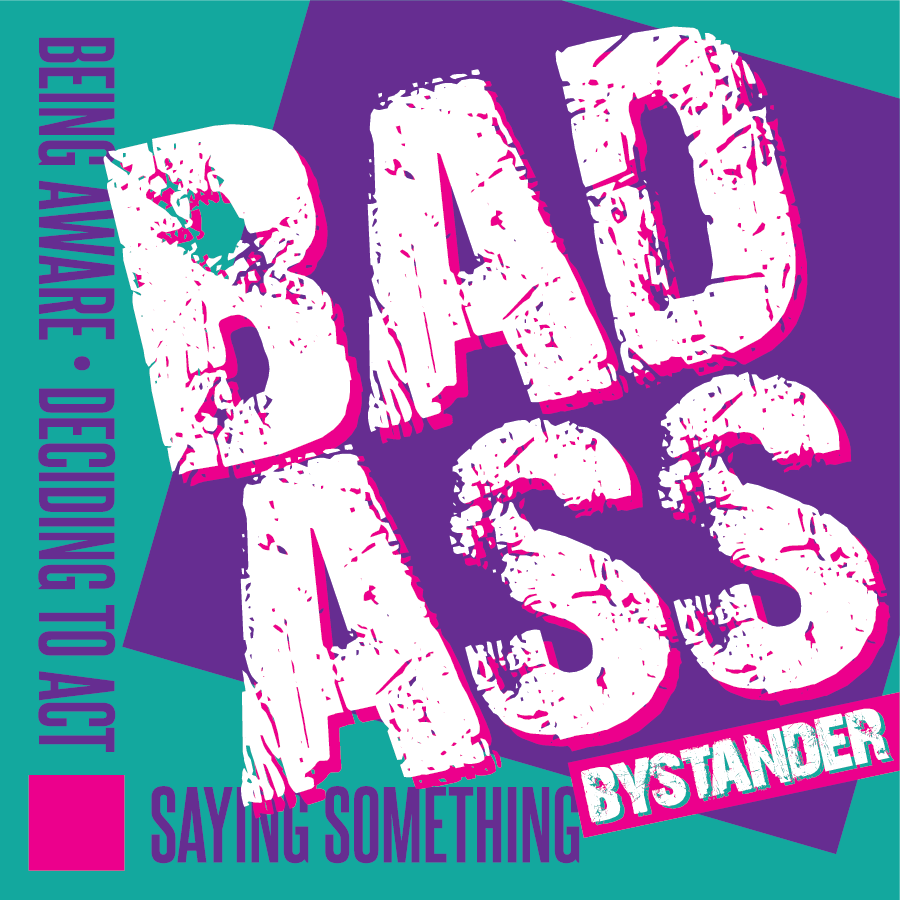U of R is BADASS! Being Aware, Deciding to Act, and Saying Something!

Bystander Intervention and Risk Reduction
Everyone has a role to play in preventing harm or violence and there are many different ways you can step up to make a difference as a bystander. By focusing on prevention and direct action, bystander intervention seeks to create a culture where harmful behaviors are less likely to occur and more likely to be addressed when they do. Bystander intervention encourages the recognition of one’s ability to positively influence the outcome, either by directly intervening, seeking help from others, or utilizing resources to support those involved. This proactive role shifts the bystander from a passive witness to an empowered participant working towards a safer and more inclusive environment.
It is important to determine as a bystander whether there is a safe and reasonable way to intervene, and to act in a way to assist a person whether it is before, during, or after an incident takes place. By intervening in the moment, bystanders may give the concerned person a chance to get to a safe place or leave a situation.
First things first – be safe. Take action only if you feel that it is safe to do so. Determine what actions you feel comfortable taking based on the situation. Choose the best method to intervene based on the circumstances, including your own personal safety.
Steps to effective bystander intervention:
- Notice the situation
- Be aware of your surroundings
- Anticipate problems/look for red flags
- Consider the best intervention strategies and the best exit strategies
- Interpret the behavior as a problem
- Check to see if others appear unconcerned
- Ask others what they think
- Be mindful of peer pressure and prepare to react to it
- Feel responsible to act
- See yourself as being part of the solution to help
- Publicly state your intention to help and enlist others to help
- Know what to do (or not do)
- Scroll down and learn more about the skills you can learn to intervene safely and effectively!
- Learn and practice these skills when possible
- Act using one of the 5D methods: Direct, Distract, Delegate, Delay, Document
- If it is safe and you are willing to help, implement the most appropriate skills and strategies = BADASS!
Use one of the 5D Methods to Intervene
The 5Ds are different methods – Direct, Distract, Delegate, Delay, Document– that you can use to support someone who’s being harassed or harmed, emphasize that harassment is not okay, and demonstrate to people in your life that they have the power to make community safer.
Anyone can use the 5Ds! They are designed to be safe and not to escalate situations. In fact, four of them are indirect methods of intervention.
Direct: Intervene directly with the involved people, alerting them to the problematic comments or actions. Speak up about the disrespectful behavior when it’s happening and try to keep it short and succinct. Be confident, assertive, and calm. Avoid engaging in dialogue, debate, or an argument. Focus your attention on assisting the person who was harmed.
Distract: Take an indirect approach to derail and de-escalate the situation. Distract either party to interrupt a situation. Distraction is a subtle and creative way to intervene. The key to distraction is to ignore the person who is harassing, and engage directly with the person who is being harassed by talking about something completely unrelated.
Delegate: Bring in someone else to help. This could be someone who may be in a better position to help with the situation, someone who knows the affected parties, or someone with more perceived authority. When you delegate someone to help you, try to tell them as clearly as possible what you’re witnessing and how you’d like them to help.
Delay: If you can’t intervene in the moment, check in later. Bystanders can reach out to those affected to link them with resources or offer emotional support.
Document: Record the interaction on your phone, take a photo of the individual causing harm, or write notes about what occurred. Afterwards, ask the person who experienced harm what they would like to do with the documentation. Although it can be helpful to document harassment, we also want to assess and ensure the person receiving harm is being helped — if they’re not, use another of the 5Ds to intervene.


